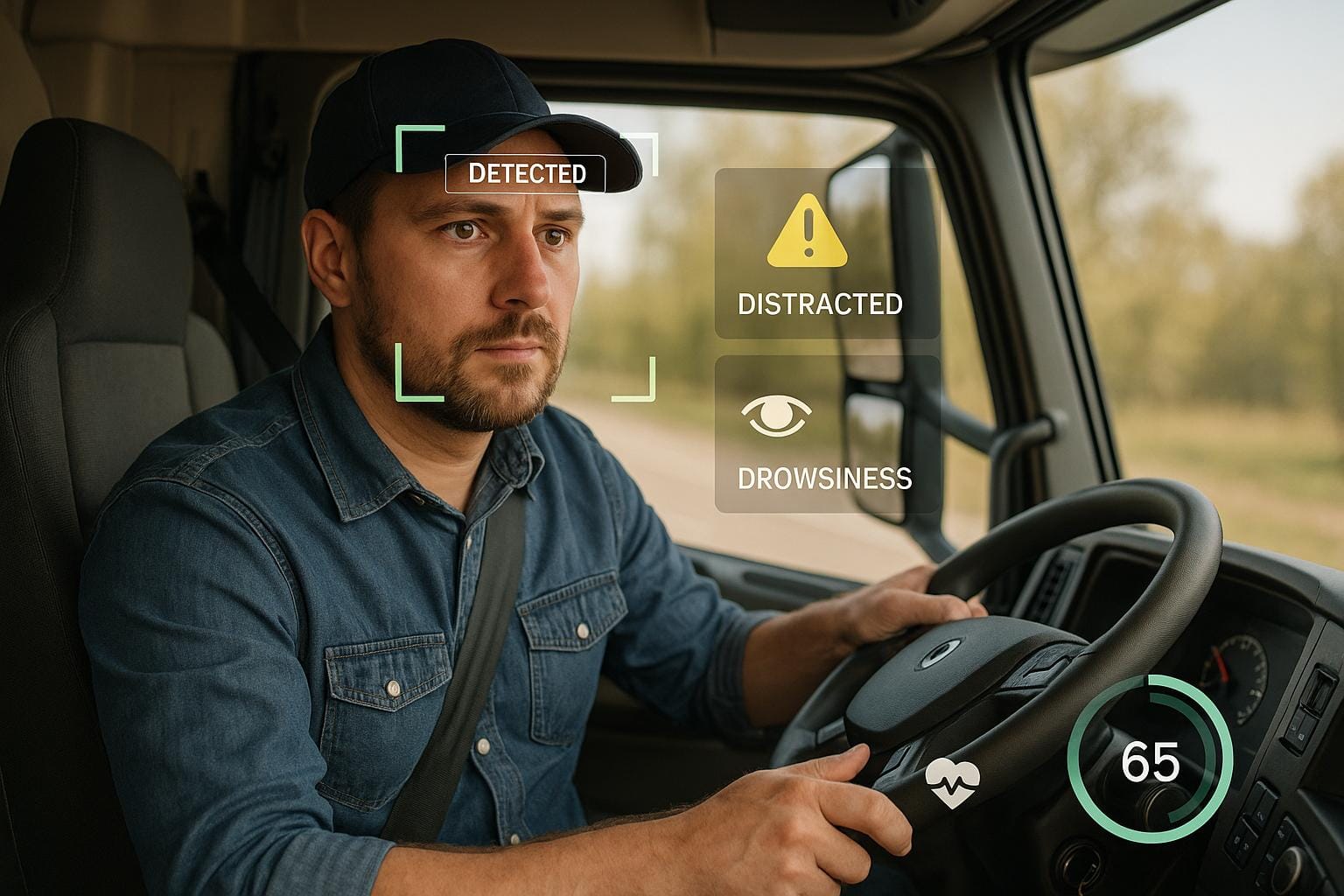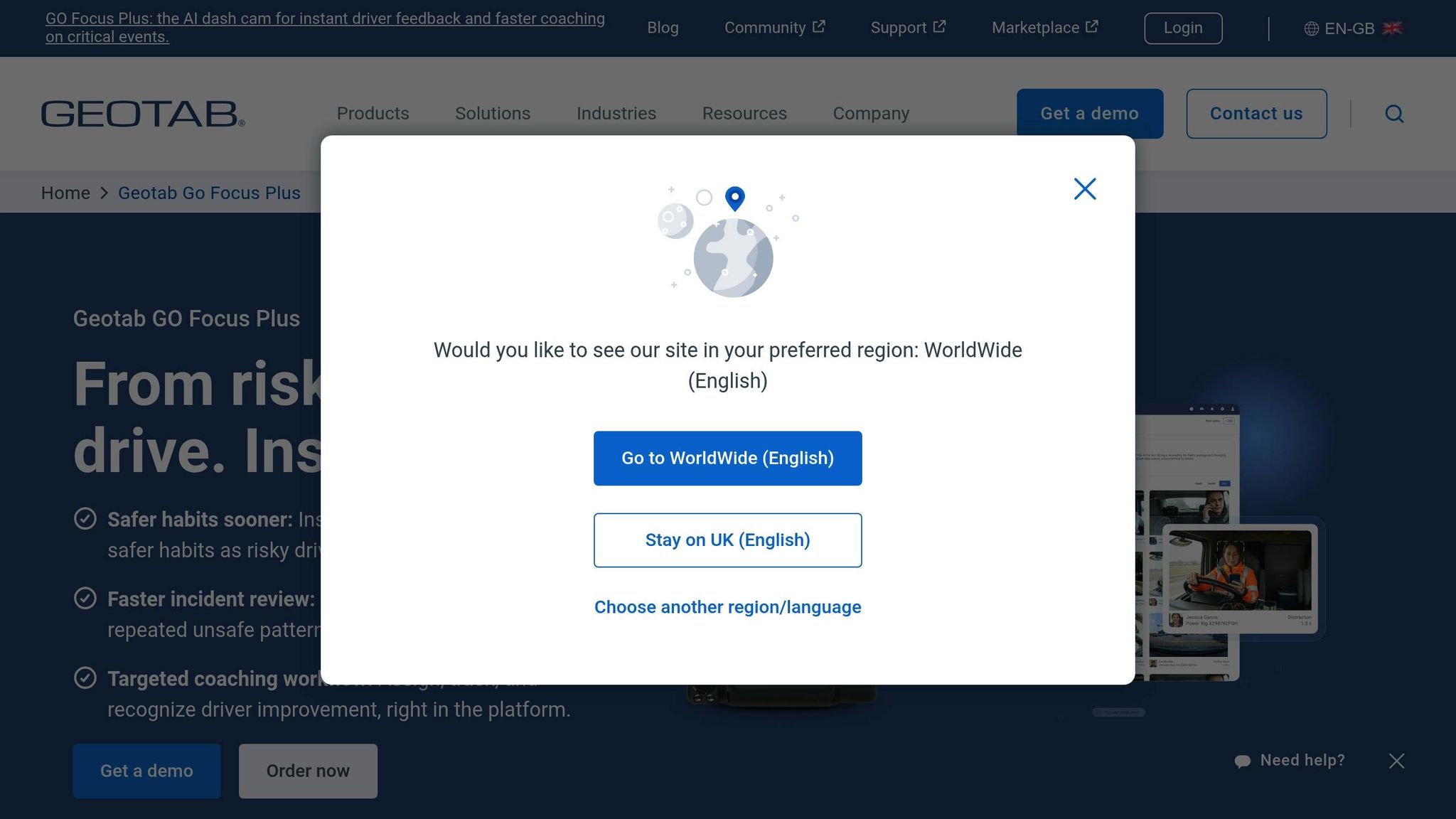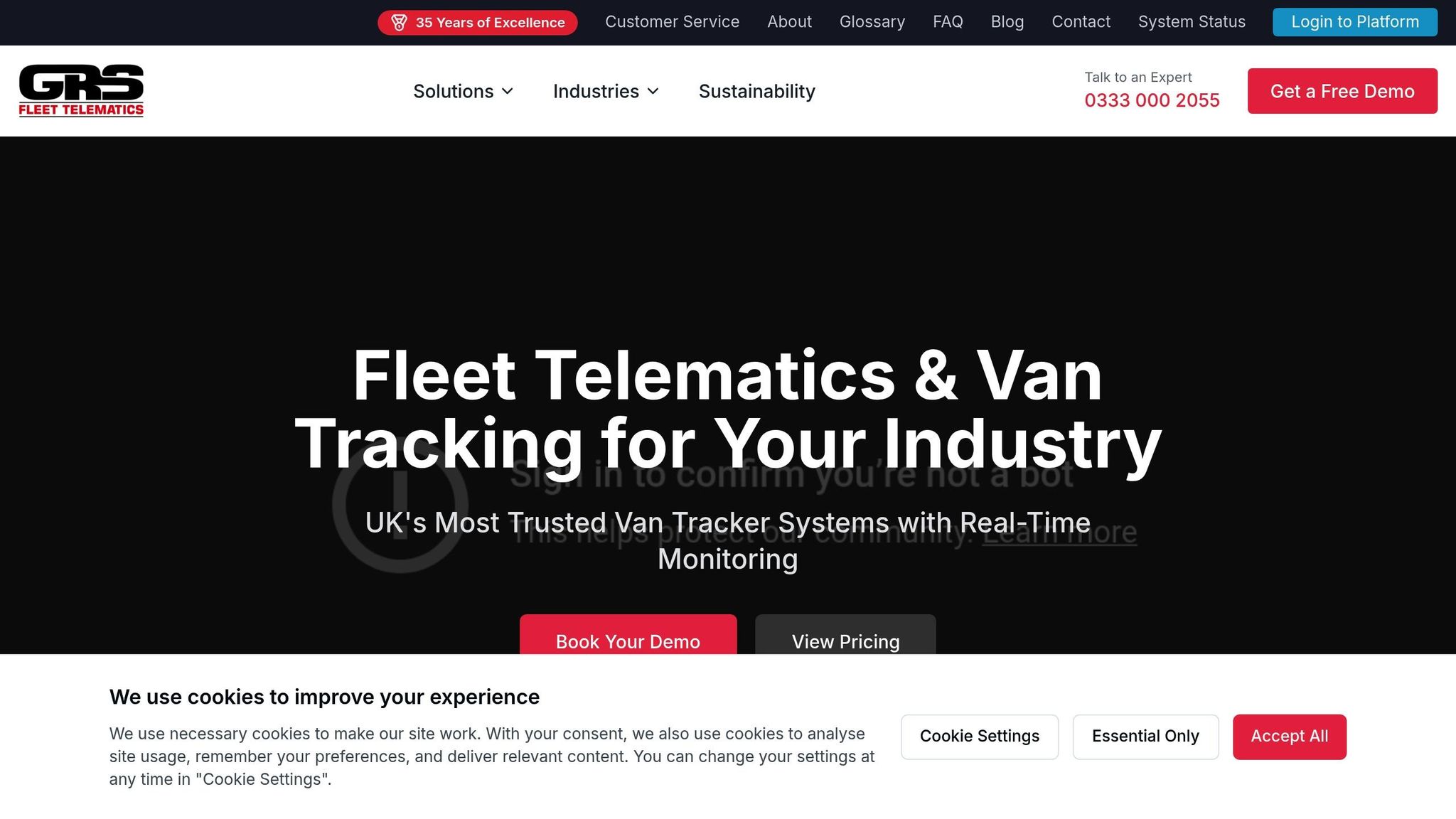AI Video Telematics for Driver Monitoring
Explore how AI video telematics is transforming driver monitoring and fleet safety with real-time alerts, analytics, and advanced security features.

AI video telematics is reshaping how fleets monitor driver behaviour by using cameras and artificial intelligence to detect issues like fatigue and distraction. This technology helps reduce accidents caused by these factors, which contribute to over 20% of serious road incidents in the UK. It also provides real-time alerts, detailed analytics, and coaching tools to improve safety and performance.
Two main approaches are discussed:
-
Standard AI Video Telematics:
- Tracks fatigue and distractions using facial and eye movement analysis.
- Provides real-time alerts and driver scorecards.
- Requires regular maintenance and raises privacy concerns.
-
GRS Fleet Telematics:
- Adds GPS-based metrics like speed and braking to driver monitoring.
- Includes dual-tracker security with a 91% stolen vehicle recovery rate.
- Offers cost-effective tiers (£35–£99) with subscriptions starting at £7.99/month.
The choice depends on your fleet's needs. AI systems are ideal for detailed driver behaviour tracking, while GRS balances safety and security at a lower cost.
How GO Focus Plus Dash Cam Uses AI to Reduce Distracted Driving

1. Standard AI Video Telematics Systems
Standard AI video telematics systems go beyond the capabilities of basic dash cameras by offering continuous, always-on monitoring. Unlike systems that only record during specific events, these advanced solutions analyse 100% of driving time, providing a comprehensive view of driver behaviour throughout every journey. By combining high-definition cameras with artificial intelligence, they pave the way for more customised fleet management strategies.
One standout feature is fatigue detection. Using computer vision, these systems observe indicators like prolonged eye closure, yawning, or head nodding. This method minimises false alarms and ensures timely interventions to prevent potential accidents.
Distraction monitoring is another critical component. These systems detect when drivers lose focus - whether by looking away from the road, using mobile phones, or engaging in other risky activities. By distinguishing between brief glances and prolonged distractions, the alerts provided are precise and actionable.
For fleet managers, performance tracking is invaluable. These systems generate detailed driver scorecards, summarising metrics such as fatigue or distraction events, response times to alerts, driving hours, and incident rates. This data helps identify risk patterns, assess driver performance, and determine if additional training or schedule adjustments are necessary.
Real-time alerts ensure immediate action when risky behaviour is detected. Drivers receive in-cab warnings - whether audible, visual, or haptic - while fleet managers are instantly notified through email, SMS, or dashboard alerts. This rapid feedback loop enhances safety on the road.
Integration with fleet management platforms is seamless, thanks to cloud-based systems. These platforms compile video footage, behavioural data, and alert histories into user-friendly dashboards. Fleet managers can review incidents, generate reports, and spot trends, while APIs support automated scheduling and targeted coaching.
Many systems now include weekly driver safety scores and trend indicators, enabling managers to monitor progress and pinpoint areas needing improvement. This data supports personalised coaching and recognition programmes, which encourage safer driving habits.
At the heart of these systems lies edge computing, which processes video data directly within the vehicle. This reduces bandwidth demands while enabling real-time analysis of facial expressions, eye movements, and head positions. The result? A detailed, real-time assessment of driver alertness throughout the journey. These standard systems set the stage for the advanced innovations discussed in the GRS Fleet Telematics approach.
2. GRS Fleet Telematics

GRS Fleet Telematics offers a well-rounded solution for fleet management that goes beyond basic tracking. It focuses on improving driver behaviour and enhancing safety, making it a valuable tool for businesses across the UK. Building on a strong history of dependable fleet management, the platform combines advanced vehicle security features with practical tools for monitoring drivers.
The system doesn't just rely on standard AI video telematics. Instead, it incorporates GPS-based metrics to track crucial safety indicators like speed, harsh braking, rapid acceleration, and unauthorised vehicle use. This data is compiled into detailed reports, helping fleet managers identify risks and focus on targeted coaching to address specific issues.
Real-time alerts are another standout feature. These notifications keep fleet managers informed about risky driving behaviours or security breaches as they happen. For those opting for the Ultimate tier, there's an added layer of security with a vehicle immobilisation feature, allowing swift action in case of an incident.
One of the platform’s unique strengths is its dual-tracker technology, which boasts an impressive 91% recovery rate for stolen vehicles - far exceeding the industry norm of 70–80%. This system combines a hardwired GPS tracker with a hidden Bluetooth backup, ensuring continuous monitoring even if one tracker is tampered with.
GRS Fleet Telematics is designed to be both scalable and budget-friendly, offering three hardware tiers to suit different needs: Essential (£35), Enhanced (£79), and Ultimate (£99). Subscription plans start at just £7.99 per month, with features like dual-tracker functionality included across tiers and vehicle immobilisation available in the Ultimate option. Fleet managers can also access cloud-based dashboards to review trip histories, driver behaviour scores, and incident reports.
The platform is flexible enough to serve both small delivery businesses and large commercial fleets. It even offers white-label branding options, allowing companies to maintain their own identity. Plus, free installation is available when combined with fleet branding services, making it easier for UK businesses to adopt this system and improve both driver safety and fleet security.
Advantages and Disadvantages
When evaluating driver monitoring solutions, it’s important to weigh their benefits against their limitations. Both standard AI video telematics systems and more comprehensive solutions like GRS Fleet Telematics offer distinct features, each catering to different operational needs.
Standard AI video telematics systems rely on machine vision and artificial intelligence to monitor driver behaviour in real time. These systems can detect issues such as fatigue or distractions, including mobile phone use or drivers looking away from the road. They provide immediate in-cab alerts to drivers and real-time notifications to fleet managers, allowing for quick intervention when needed.
One major advantage is the significant reduction in manual footage review. For instance, a fleet generating 1,000 video clips a week may only need to review a very small number of alerts, cutting manual workload by 99%.
However, these systems are not without challenges. False positives, such as incorrectly identifying driver fatigue or distractions, can be frustrating. Privacy concerns among drivers are another hurdle, potentially slowing adoption. Additionally, these systems require regular calibration and maintenance, and their performance can be influenced by factors like lighting conditions or improper camera placement.
On the other hand, GRS Fleet Telematics presents a more holistic solution by combining driver monitoring with advanced vehicle security. Its dual-tracker technology boasts an impressive 91% recovery rate for stolen vehicles. Beyond security, the system uses GPS-based metrics to track key safety indicators such as speed, harsh braking, and rapid acceleration.
GRS Fleet Telematics is designed for ease of use, offering professional installation, an intuitive mobile app, and 24/7 customer support. For businesses, the white-label option allows them to retain their branding while benefiting from advanced tracking and monitoring features.
Here’s a side-by-side comparison to help understand the differences:
| Aspect | Standard AI Video Telematics | GRS Fleet Telematics |
|---|---|---|
| Functionality | Real-time fatigue and distraction alerts; performance tracking | GPS-based driver monitoring, dual-tracker security, vehicle immobilisation, 91% recovery rate |
| Cost-Effectiveness | Variable pricing; advanced features can increase subscription costs | Budget-friendly, starting at £7.99/month with clear hardware options |
| Integration | Cloud-based; may face compatibility issues with older systems | Seamless integration with UK fleet management systems; professional installation |
| Privacy Considerations | Requires strong data protection; potential driver concerns | Focuses on security, raising fewer privacy concerns compared to video-based systems |
| Maintenance | Needs regular calibration; environmental factors can impact performance | Minimal upkeep; durable hardware design |
Ultimately, the choice between these solutions will depend on your fleet’s specific requirements. Standard AI video telematics is ideal for operations that prioritise detailed driver behaviour analysis. In contrast, GRS Fleet Telematics offers a secure, affordable option with straightforward implementation. Regardless of the choice, compliance with UK GDPR and open communication with drivers are crucial for successful integration.
Summary
Comparing standard AI video telematics systems with GRS Fleet Telematics highlights two distinct approaches to driver monitoring, each tailored to different operational needs and budgets.
Standard AI video telematics systems shine when it comes to analysing driver behaviour in depth. These systems offer real-time fatigue and distraction detection, paired with instant in-cab alerts. They also provide detailed performance analytics, making them a powerful tool for improving fleet safety. With their advanced capabilities, these systems play a critical role in preventing accidents before they happen, making them ideal for fleets with complex safety requirements.
On the other hand, GRS Fleet Telematics focuses on security, blending essential driver monitoring with top-tier theft protection. Its high recovery rate underscores its effectiveness in this area, while its budget-friendly monthly plans appeal to UK businesses looking for reliable fleet protection without the added complexity of advanced video analytics.
Fleet size also plays a key role in determining the best fit. Large fleets with intricate safety demands often benefit from standard AI video telematics, which can accommodate multi-camera setups and compliance reporting. Meanwhile, small to medium-sized fleets - particularly those operating in areas prone to theft - may find GRS Fleet Telematics strikes the right balance between security, monitoring, and affordability.
Cost is another differentiating factor. Standard AI systems typically come with higher upfront hardware expenses and ongoing subscription fees for advanced analytics. GRS Fleet Telematics, however, offers straightforward pricing, with hardware options ranging from £35 for basic tracking to £99 for comprehensive security features.
Ultimately, the choice depends on operational priorities. Fleets focused on detailed driver coaching, compliance reporting, and accident prevention might lean towards advanced AI video telematics. In contrast, those prioritising vehicle security, theft recovery, and simplified driver monitoring may find GRS Fleet Telematics better suited to their needs. Considering that driver fatigue and distractions contribute to over 20% of road accidents in the UK, both systems address critical safety concerns, albeit through different approaches.
FAQs
How does AI video telematics help detect driver fatigue and distractions, and what are the key signs it monitors?
AI video telematics leverages advanced algorithms to keep a close eye on driver behaviour, spotting signs of fatigue and distractions as they happen. By examining facial expressions, eye movements, and head positioning, the system can recognise when a driver is becoming drowsy or losing concentration. It also picks up on patterns like frequent yawning, prolonged eye closures, or minimal steering activity.
If any risks are detected, the system sends instant alerts to the driver, aiming to reduce accidents and boost safety on the road. This forward-thinking approach not only helps drivers stay alert but also assists businesses in ensuring their fleets operate more safely.
How does GRS Fleet Telematics' AI video telematics system stand out in terms of features and affordability?
GRS Fleet Telematics' AI-powered video telematics system takes driver monitoring to a new level with features like dual-tracker technology, which significantly boosts vehicle security. Impressively, it boasts a 91% recovery rate for stolen vehicles. The system also offers real-time tracking, detailed driver behaviour analysis, and insights into fleet performance, giving businesses the tools they need to manage their fleets safely and efficiently.
One of the standout aspects of GRS Fleet Telematics is its budget-friendly pricing. Starting at just £7.99 per month, it includes all essential features upfront with no hidden fees. This makes it a smart and economical choice for UK businesses seeking dependable telematics solutions.
What are the privacy concerns around AI video telematics, and how can they be addressed?
Privacy is a major consideration when implementing AI video telematics systems, as these technologies handle sensitive data. To ensure user information is protected and regulations are met, stringent measures need to be in place.
GRS Fleet Telematics places a strong emphasis on privacy and security. By employing advanced data encryption and strictly following legal requirements, their systems deliver real-time monitoring while maintaining driver confidentiality. This approach allows businesses to operate confidently, knowing performance isn’t sacrificed for privacy.
